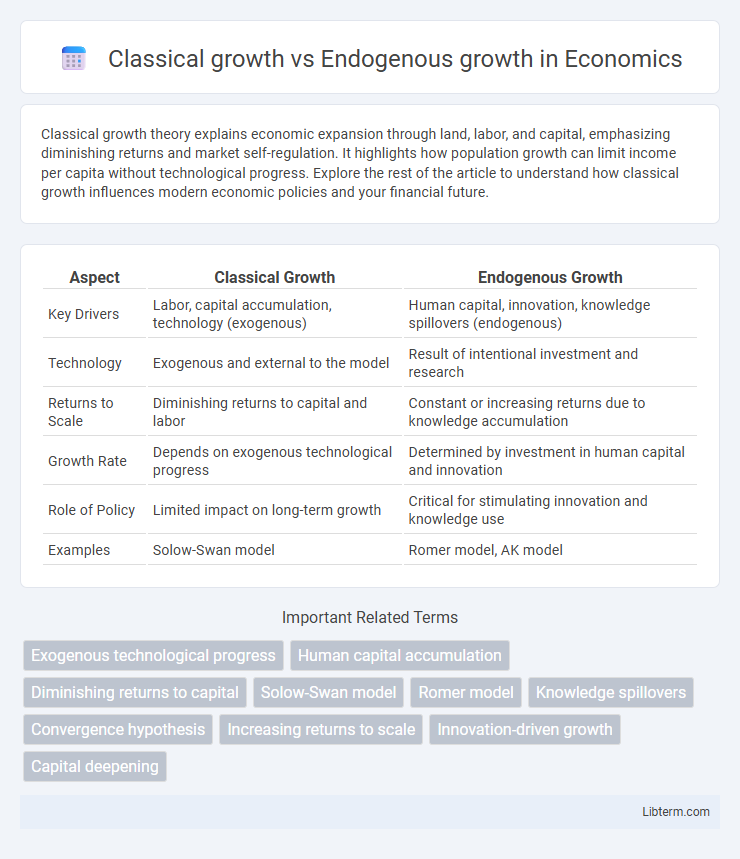Classical growth theory explains economic expansion through land, labor, and capital, emphasizing diminishing returns and market self-regulation. It highlights how population growth can limit income per capita without technological progress. Explore the rest of the article to understand how classical growth influences modern economic policies and your financial future.
Table of Comparison
| Aspect | Classical Growth | Endogenous Growth |
|---|---|---|
| Key Drivers | Labor, capital accumulation, technology (exogenous) | Human capital, innovation, knowledge spillovers (endogenous) |
| Technology | Exogenous and external to the model | Result of intentional investment and research |
| Returns to Scale | Diminishing returns to capital and labor | Constant or increasing returns due to knowledge accumulation |
| Growth Rate | Depends on exogenous technological progress | Determined by investment in human capital and innovation |
| Role of Policy | Limited impact on long-term growth | Critical for stimulating innovation and knowledge use |
| Examples | Solow-Swan model | Romer model, AK model |
Introduction to Economic Growth Theories
Classical growth theory emphasizes long-term economic expansion driven by capital accumulation, labor force growth, and diminishing returns due to finite resources. Endogenous growth theory highlights the role of internal factors like technological innovation, human capital, and knowledge spillovers as key drivers of sustained economic growth. These theories frame economic development by contrasting exogenous limitations with internal growth mechanisms within an economy.
Defining Classical Growth Theory
Classical Growth Theory, rooted in the works of Adam Smith and David Ricardo, emphasizes that economic growth is driven primarily by capital accumulation, labor force expansion, and technological progress as an external factor. It suggests diminishing returns to capital and the eventual stagnation of growth due to resource constraints and population pressure. In contrast, Endogenous Growth Theory integrates technological innovation and human capital development as internal to the economic system, promoting sustained growth without the constraints predicted by classical models.
Key Principles of Endogenous Growth Theory
Endogenous growth theory emphasizes that economic growth is primarily driven by internal factors such as human capital, innovation, and knowledge spillovers, unlike classical growth models which rely on exogenous technological progress. It highlights the role of policy measures and investments in education and research and development (R&D) in sustaining long-term growth. The theory also suggests that returns to scale increase with knowledge accumulation, leading to persistent growth without diminishing returns.
Historical Context and Evolution
Classical growth theory, rooted in the works of Adam Smith and David Ricardo during the 18th and 19th centuries, emphasized limits to growth due to land scarcity and diminishing returns in agriculture within an agrarian economy. Endogenous growth theory emerged in the late 20th century, pioneered by economists such as Paul Romer and Robert Lucas, highlighting the role of technology, human capital, and innovation as internal drivers of sustained economic growth without natural resource constraints. This evolution reflects a shift from viewing growth as an external process influenced by exogenous factors to one generated by policies, investments, and knowledge within the economic system.
Drivers of Classical Growth
Classical growth theory primarily attributes economic growth to capital accumulation, labor force expansion, and technological progress as exogenous factors. The diminishing returns to capital and fixed land resources limit the long-term growth rate, leading to a steady-state equilibrium. Population growth and exogenous technological improvements serve as main drivers in the Classical growth framework.
Core Mechanisms in Endogenous Growth
Classical growth theory emphasizes exogenous factors such as technological progress and capital accumulation as drivers of economic growth, typically treating technological change as an external force. Endogenous growth theory, in contrast, focuses on internal mechanisms like human capital development, innovation, and knowledge spillovers that generate sustained economic growth from within the system. Core mechanisms in endogenous growth include R&D investment, learning-by-doing, and increasing returns to scale in knowledge creation, which collectively enhance productivity and foster continuous innovation.
Role of Technology and Innovation
Classical growth theory attributes technological progress to external factors and treats it as an exogenous variable driving long-term economic growth. Endogenous growth theory emphasizes that technology and innovation result from intentional investments in research and development, human capital, and knowledge creation within the economy. This framework highlights the pivotal role of innovation policies and spillover effects in sustaining continuous growth without relying on external technological advancements.
Human Capital in Growth Models
Classical growth models emphasize physical capital accumulation and diminishing returns, treating human capital as an exogenous factor with limited impact on sustained growth. Endogenous growth models integrate human capital as a central driver, highlighting its role in innovation, knowledge spillovers, and increasing returns that fuel long-term economic growth. Empirical evidence supports endogenous theories by showing that investments in education, skills development, and knowledge enhance productivity and innovation, thereby sustaining growth beyond physical capital constraints.
Policy Implications and Recommendations
Classical growth theory emphasizes capital accumulation and diminishing returns, suggesting policies that focus on savings rates, investment incentives, and technological diffusion to sustain growth. Endogenous growth theory highlights innovation, knowledge spillovers, and human capital as central drivers, advocating for investments in research and development, education, and infrastructure to foster long-term economic expansion. Policy recommendations based on endogenous growth stress the importance of intellectual property rights, innovation subsidies, and continuous skill development to enhance productivity and mitigate technological stagnation.
Comparative Analysis: Classical vs. Endogenous Growth
Classical growth theory emphasizes the role of labor, capital, and diminishing returns, leading to steady-state equilibrium with limited long-term growth potential. Endogenous growth theory incorporates innovation, human capital, and knowledge spillovers as internal drivers, fostering sustained economic expansion without diminishing returns. Comparative analysis highlights that endogenous models better explain persistent technological progress and policy impact on growth rates, unlike classical models constrained by fixed factors.
Classical growth Infographic

 libterm.com
libterm.com